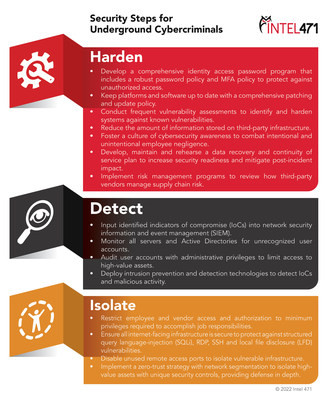TMCnet News
Intel 471 Introduces The 471 Cyber Threat ReportData-driven report analyzes emerging cyber threats and trends that will dominate into 2023 WILMINGTON, Del., Aug. 4, 2022 /PRNewswire/ -- Intel 471, the premier provider of cyber threat intelligence for leading intelligence, security, and fraud teams across the globe, today released The 471 Cyber Threat Report; 2022-2023 Trends & Predictions. This research analyzes recent and commonly used tactics, techniques and procedures (TTPs) that have been adopted by prominent threat actors, how these threats have affected enterprises, along with predictive intelligence assessments on threats that organizations should be prepared to thwart over the next year. The report details the most impactful threats that fueled the cybercrime ecosystem over the past year and the TTPs employed by the actors behind them. It provides recommended steps organizations should take to protect themselves against existing and emerging threats on the horizon. "It is important to not only draw attention to the TTPs commonly used by the most capable threat actors but also to provide rich context for how these TTPs can impact organizations at every stage of the cyberattack chain, and how they can be countered by tactical defenders and senior decision makers," said Intel 471 Chief Intelligence Officer, Michael DeBolt. "The findings of our latest research will help arm organizations with the adversary, credential, malware and vulnerability intelligence they need to refine their cyber defense strategy, adjust their security practices and prepare for 2023." Other key takeaways from the report include:
"With the constant evolution throughout the cyber threat landscape and resilience that threat actors continue to display, organizations need insights based on research and intelligence surrounding the most prominent threat actors to understand their activities and to stay ahead of the next attack," DeBolt added. "Just as threat actors and groups are adjusting their methods to remain resilient against new and emerging security measures, organizations should be staying abreast of key TTPs employed by adversaries and adjusting their security systems based on that intelligence to tackle new and refined ways of being compromised." The report also includes case studies on LockBit 2.0, the most impactful ransomware strain observed by Intel 471 from November 2021 through May 2022, and the release of version 3.0, which is shaping up to be just as impactful as 2.0, as well as on the 2022 Russian invasion of Ukraine and subsequent appearance of pro-Russian hacktivist groups. To help organizations protect themselves from threat actors and their continuously evolving TTPs, The 471 Cyber Threat Report includes a series of mitigation recommendations to help organizations and their security teams harden their security practices, detect potential threats, and isolate their sensitive information to avoid falling victim to new ransomware strains and malware. You can download the full report here. About Intel 471 Intel 471 empowers enterprises, government agencies, and other organizations to win the cybersecurity war using near-real-time insights into the latest malicious actors, relationships, threat patterns, and imminent attacks relevant to their businesses. The company's TITAN platform collects, interprets, structures, and validates human-led, automation-enhanced results. Clients across the globe leverage this threat intelligence with our proprietary framework to map the criminal underground, zero in on key activity, and align their resources and reporting to business requirements. Intel 471 serves as a trusted advisor to security teams, offering ongoing trend analysis and supporting your use of the platform. Learn more at https://intel471.com/. Media Contact:
SOURCE Intel 471 
|


